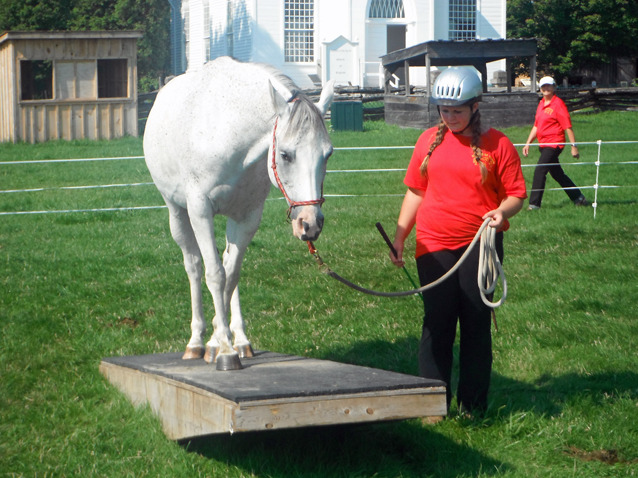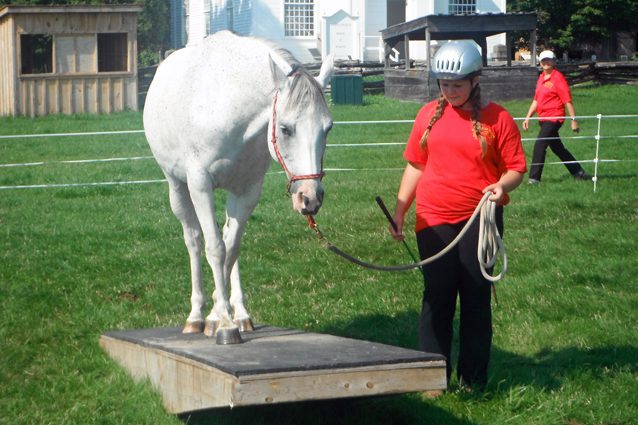
CFN– This Column of “Spirits in Unity” is being published by CFN for the community of Stormont, Dundas & Glengarry.
Thanks to all those who have approached me to say that they enjoy reading this column. Knowing that someone is reading the column encourages us to keep writing them.
This week’s Topic: Knowing When to Encourage
Hey wait a minute” those of you who have been reading these columns may be saying to yourself. “I thought you said that you shouldn’t encourage”
You are right, you should not coax or encourage an unconfident horse or person, but that is not to say that encouragement is bad. It is a case of knowing when it is the right time to encourage.
There is an old cowboy saying that goes, “Don’t ask a galloping horse to gallop”. Simply put it means don’t ask a trying horse to try. This is true for both horses and humans. When your horse is trying to do something, leave him alone. Asking him to try harder at that moment can just cause him to lose confidence because it feels like pressure. When I tell my students this they often tell me how teachers often ask them to try harder when they are already trying. They say to me, “Don’t they know that I am already trying?”
Sometimes knowing if a horse is actually trying is not as easy as it may seem. Often he is trying very hard internally, but it is difficult to recognize the signs of a trying horse. That is even more true with humans because we are so good at masking our ‘trying’ behaviour.
When a horse is not trying, it is important to figure out why. Is he afraid or is he arguing with you? Fear is a right-brain reaction, arguing is a left-brain reaction and while you would think that it easy to tell the difference, there are still situations when people refer to their horse as being ‘disrespectful’ (rude or ill-mannered) when in fact it is fear.
Left-brain horses may disagree with you, but they are not wide-eyed, tense and afraid. Their movements are not as quick or frantic. Their movements tend to be slower and more dogged. This doesn’t mean that you should get in a fight or argument with him, but it does mean that you need a different strategy. This horse has to believe in you as a good leader, but the right-brain horse has to be convinced that you are not going to kill him. That is why the principle of retreat works as a strategy, but encouragement at that moment does not.
By using the approach and retreat strategy, the horse will become more confident and even curious. It is in this state that you can encourage – but you can only do it once. You ask him to do something and then you allow him to try to do it. But if you keep asking him to try harder you undermine his ability to think for himself by micromanaging him.
This is also true when dealing with teaching of children. As a teacher, one of the most difficult things for me is keeping my mouth shut and allowing my students to experience the ‘try’ for himself, even if I have an overwhelming desire to help him along.
If you don’t do this you end up micromanaging your student (horse or human) and stifling his ability to learn for himself.
Suppose you are asking your horse to do something and you see how far he gets. When he reaches a threshold just wait and see what he is going to do. It could be one of the following things:
1. Stop and think
2. Turn and escape
3. Stop and do what you asked.
4. Just do it.
If you don’t allow your horse to choose at this point, you have no way to read his intention and therefore you will not be able to support it in the appropriate way. The potential for your horse is that you can blow him up.
For humans it often results in them tuning out and eventually ignoring you as a teacher.
The time to encourage is when your horse is confident and seems to know what to do. He is standing at an obstacle or threshold, calmly and without curiosity or resistance (and he is not introverted or hiding). At that moment you can add that extra little bit of encouragement, but only once.
Think of encouragement as support. Encourage is not a euphemism for force. For horses it might be a slight tap, but not a smack.
Next time your student (horse or human) reaches a threshold, try and apply these principles and see how well they work for you.
On Nov. 23(eve) and 25(all day) please plan on visiting the Rothwell Osnabruck Trade and Craft Show in Ingleside, Ont. We will be there with a booth to unveil our new photo journal. Drop by and say hello. You can get a sneak preview at www.spiritsinunity/shutterfly.com
Be sure to click on the ‘like’ or ‘dislike’ buttons to let us know that you have read today’s column. It is an honour to have you as a reader. I welcome any comments, questions or topics you would like me to discuss. I hope you enjoy reading about the wonderful world of horses.
In our ‘Spirits in Unity’ program we believe in developing a trusting relationship and a true partnership with a horse before even thinking about getting on his back. He probably prefers it that way too.
Whether you are just a horse lover, have dreams of owning a horse someday, or already have one, I hope these columns will give you some insight into the true nature of these magnificent creatures. I hope you will find them both informative and inspirational.
Until next time…
May all your dreams come true,
Garry “Horsetalker” Meek

